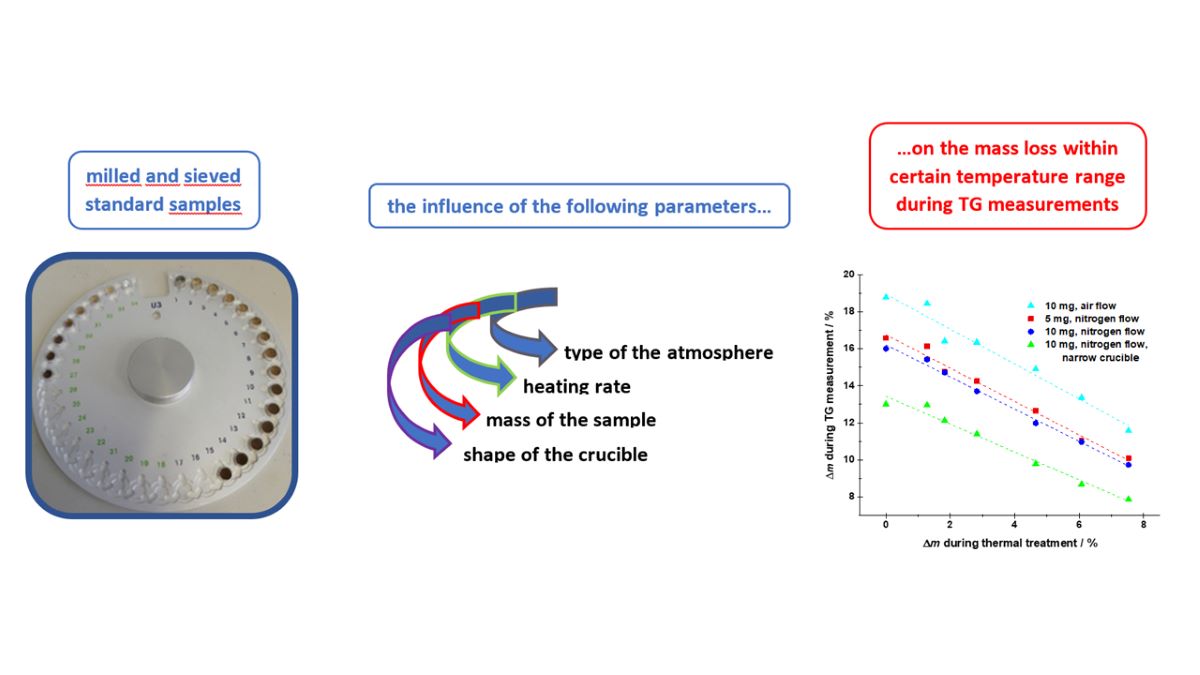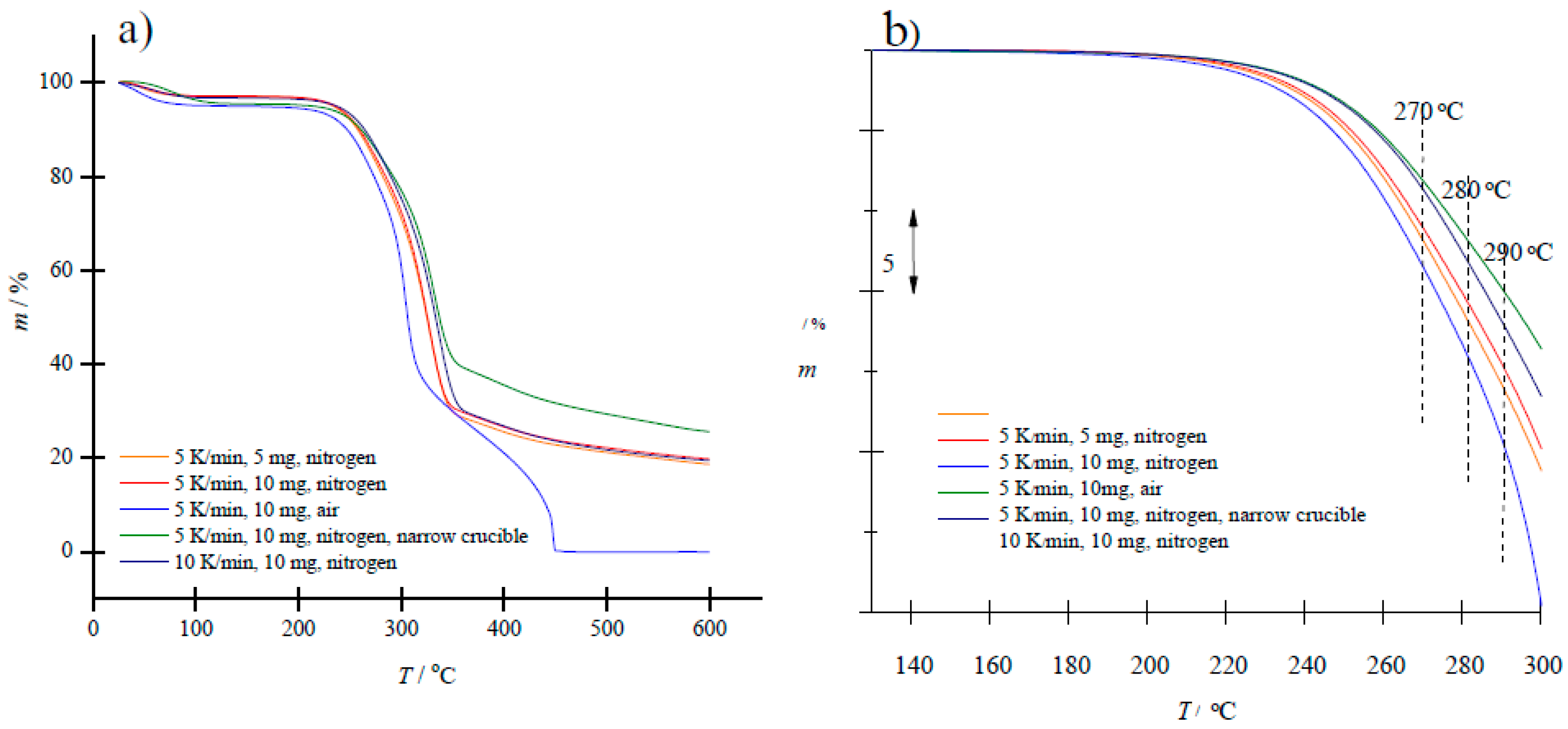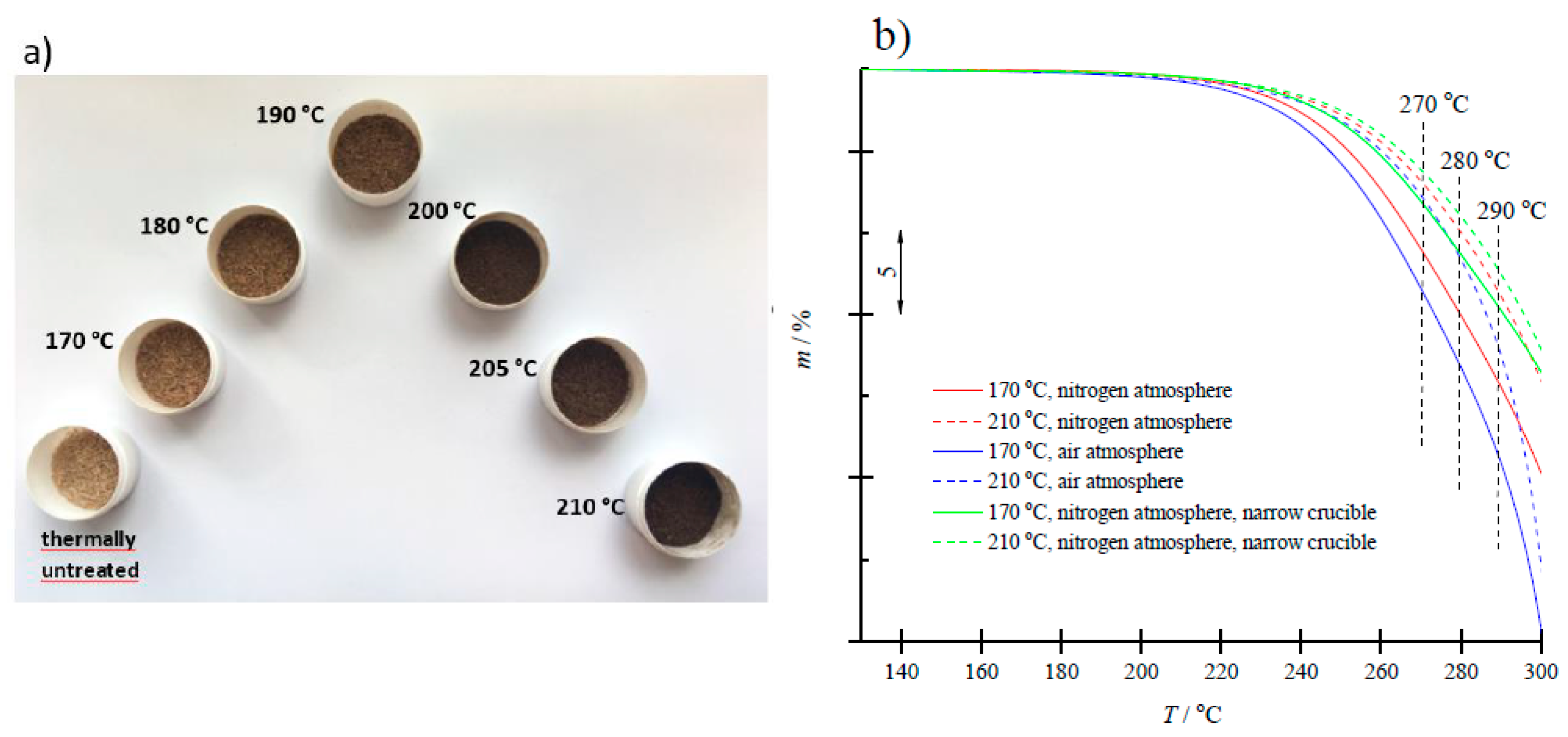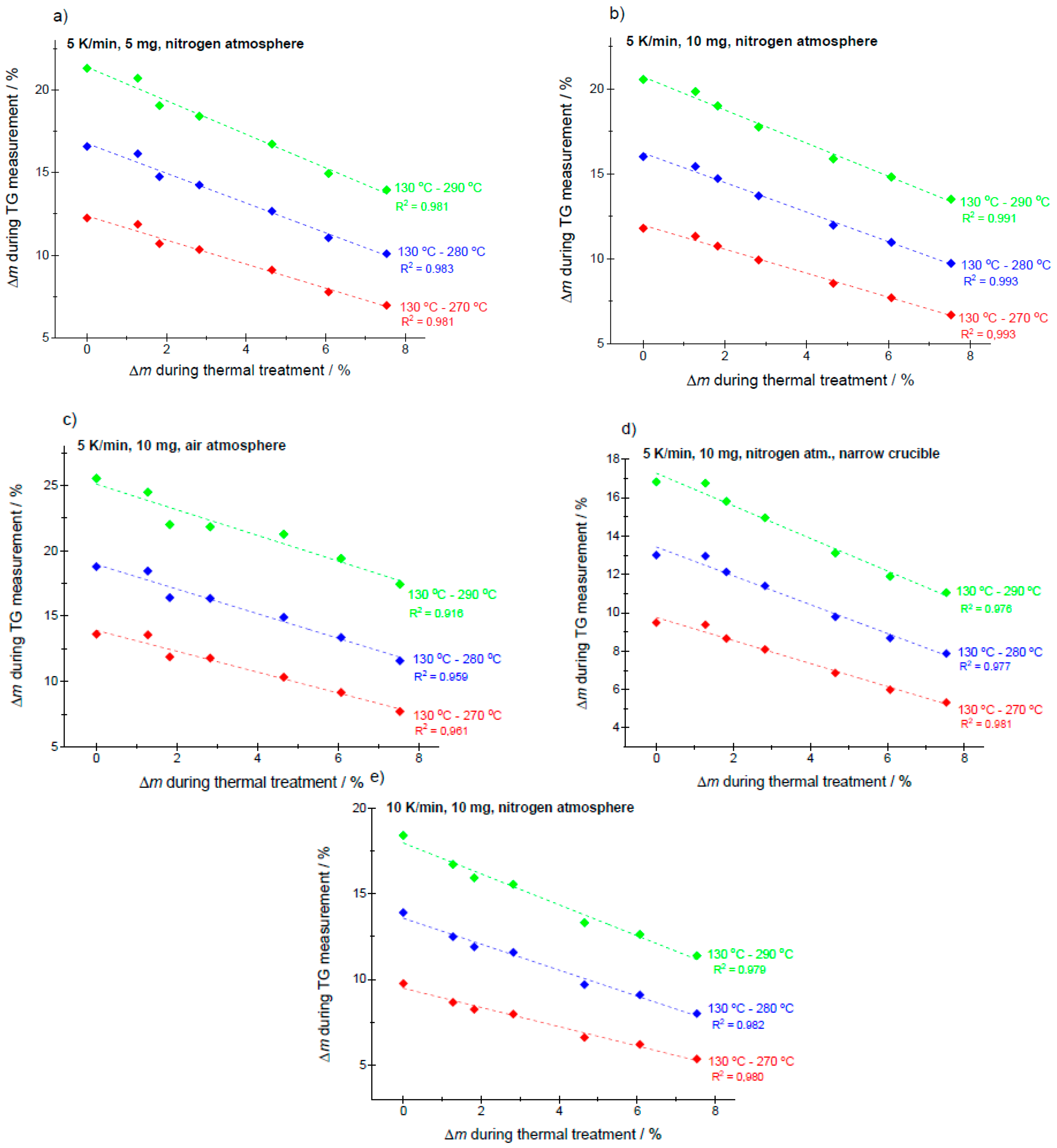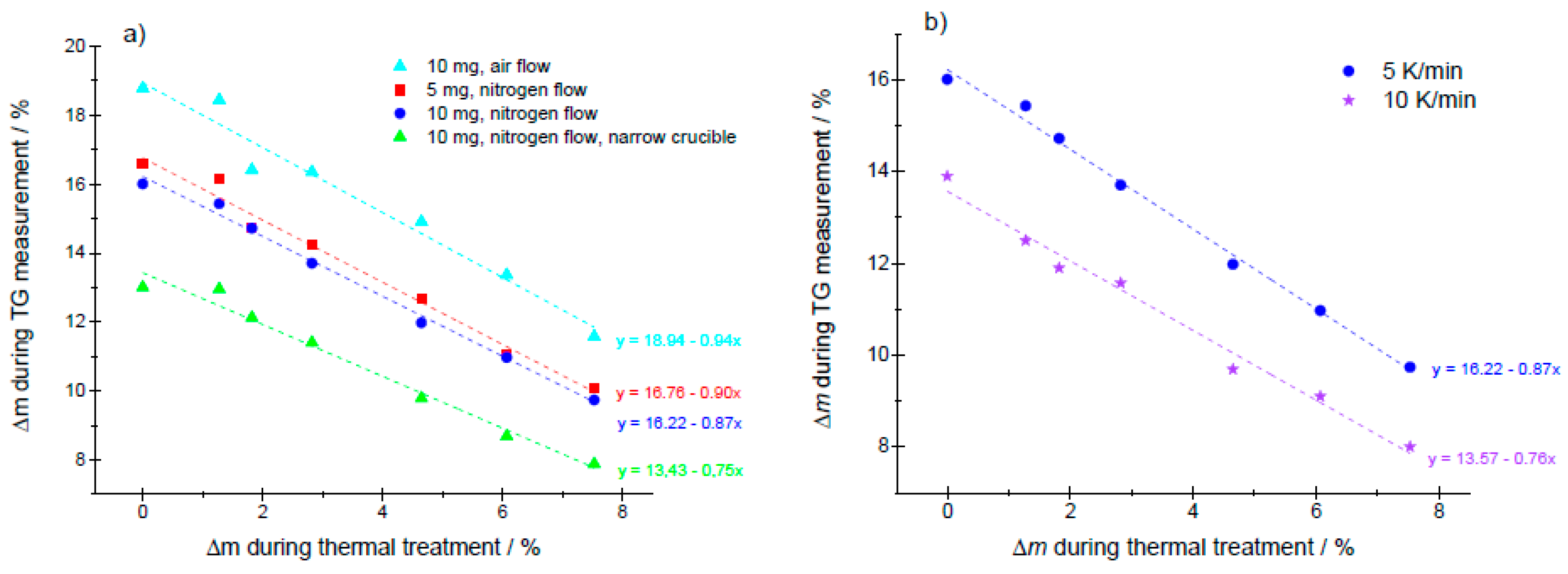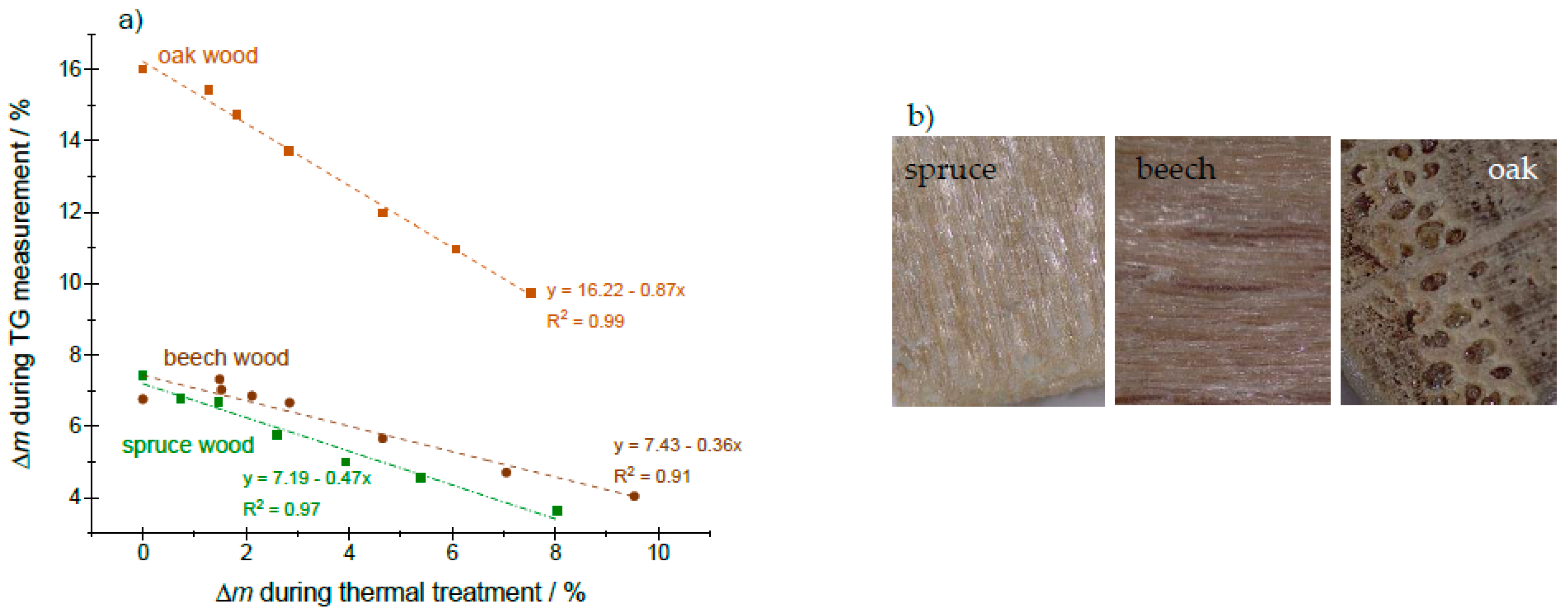1. Introduction
Most European wood species begin to decay when exposed to temperatures above freezing and increased moisture content in the range of fibre saturation. Decomposition processes are desirable in nature, but when wood is used for commercial purposes, we want to slow down these processes as much as possible. In the past, mainly biocides and more durable tropical wood species were used, but these solutions are increasingly undesirable due to growing environmental awareness. One of the possible approaches for non-biocidal wood protection is thermal modification. During modification process, wood is exposed to elevated temperatures (between 170 °C and 240 °C) under semi-anoxic conditions (either in a vacuum, in an inert atmosphere, in water vapour, or in hot oil) [
1]. During this process, several chemical changes take place in the main components of the cell wall (hemicelluloses, cellulose, and lignin), which permanently alter the properties of the wood. The changes are reflected in lower equilibrium moisture content, better dimensional stability, and increased resistance to wood-degrading organisms, but on the other hand, mechanical properties may also deteriorate [
2]. Thermally modified wood is commonly used for non-structural exterior applications such as claddings and decking, windows, fences, and garden furniture. However, it can also be used for interior decorative purposes as it also changes colour during modification [
3].
For a more detailed description of the processes that occur during thermal modification, a brief description of wood polymers is necessary. The main structural component of a wood cell wall is the cellulose skeleton, which content ranges between 40% and 46% in softwood and between 44% and 49% in hardwood [
4]. Cellulose is a homopolysaccharide consisting of β-D-glucopyranose units linked by (1-4)-glycosidic bonds. Cellulose molecules form intra- and intermolecular hydrogen bonds that connect them to form microfibrils in which crystallized regions alternate with amorphous regions. The degree of polymerization of cellulose in the cell wall is up to about 10,000. The crystallites in which the cellulose molecules run in parallel are 30 nm to 60 nm long. Hemicelluloses or polyoses are non-cellulosic polysaccharides which, in contrast to cellulose, consist of different sugar units (various pentoses and hexoses and sometimes glucuronic acid molecules). The degree of polymerization of their molecular chains is up to 200, so they are much shorter and more branched. Hemicelluloses can be hydrolyzed into their monomeric components relatively easily; their content in softwoods is somewhat lower (between 26% and 33%) than in hardwoods (27–34%) [
4]. Lignin is a three-dimensional polymer composed of phenylpropane units. Lignin is deposited in the intercellular and interfibrillar spaces of the cell wall, after cellulose and hemicellulose have already been deposited. On average, its content is higher in conifers (e.g. 28% in spruce) than in hardwoods (between 22% and 24% in beech) [
5].
In terms of thermal stability, hemicelluloses are the least stable wood polymer, which only begins to decompose when heat treated at about 180 °C [
6]. Acetic acid is released from the hemicellulose (the acetate groups are bound to the hemicelluloses in the form of an ester), which lowers the pH of the wood. The content of acetyl groups in wood depends on the wood species and varies on average between 1% and 6% [
7]. The release of acetic acid, which catalyzes the depolymerization of carbohydrates, mainly causes the depolymerization of hemicellulose chains into smaller units. The less ordered, amorphous cellulose is also deacetylated and decomposed, decreasing the mechanical strength of the wood. In this temperature range, intramolecular dehydration also occurs, leading to the formation of furfural-like compounds [
8].
Since mainly hemicellulose and amorphous cellulose are degraded at the beginning of the heat treatment, the degree of crystallinity of the heat-treated wood increases. X-ray diffraction analysis shows that crystalline cellulose in wood decomposes only at about 320 °C [
9]. This temperature is not reached during heat treatment [
10].
With heat treatment above 200 °C, the lignin content also increases due to the decreasing carbohydrates content. In addition, at about 200 °C, demethoxylation of lignin (cleavage of the –OCH
3 group) begins, causing an increase in the free reactive sites on the aromatic rings of lignin and condensation of individual lignin units via methylene bridges. Electron spin resonance showed a sharp increase in stable free radicals in heat-treated wood [
6]. These are formed during the demethoxylation of lignin. Reactive free radicals lead to cross-linking reactions of lignin (autocondensation) and lignin with other wood components [
11]. The proportion of these reactions is small, but they are important due to a cross-linked lignin-carbohydrate complex formation, which reduces hygroscopicity and increases the dimensional stability of the wood [
12]. The reduced hygroscopicity and increased dimensional stability after thermal treatment are explained by the fact that the cellulose microfibres are surrounded by a harder and less elastic wrap due to the increased cross-linking with the lignin complex [
12]. In this form, the cellulose microfibers have a lower ability to absorb water between the cellulose chains, which prevents cell wall swelling. A small contribution to the reduction of hygroscopicity is also made by the released acetic acid, which binds with an ester bond to the free hydroxyl groups of the wood components, which are no longer available to bind water molecules [
12]. However, the main contribution to the reduction of hygroscopicity is the degradation of hemicellulose, the most hydrophilic component of wood, which is partially selectively converted into a hydrophobic network during heat treatment. The gradually darker colour of the wood, which is more noticeable with more intensive heat treatment, results from the formation of oxidized decomposition products such as quinones [
12].
All of the above changes in wood properties tend to correlate well with mass loss or the degree of modification, which depends largely on temperature and modification duration [
13]. These two parameters can be monitored and changed during this process.
In practice, users are often confronted with problems related to the quality of modified wood, e.g. poor mechanical properties, and complain mainly about the lack of appropriate quality control of thermally modified wood. There is a lack of standardized quality control method for determination of the degree of heat treatment of the wood and thus its quality [
14].
Thermogravimetry (TG) could be one of appropriate techniques for subsequent determination of the mass loss of a single wood specimen, which took place during the thermal modification process [
15,
16]. The proposed method assumes that processes that did not occur during thermal modification continue during heating when the TG experiment is performed. First, calibration curves for standard samples have to be established. TG measurements of the prepared samples for which the mass loss during thermal modification is known (standard samples) are performed, and then the mass loss within a certain but equal temperature range during TG measurement is plotted against the mass loss during thermal modification. The latter parameter is determined by weighing the dried samples before and after modification. Thereafter, milled and sieved samples are prepared for the thermogravimetric measurements.
It is known that several factors divided into instrumental parameters (heating rate, type of atmosphere - inert, reducing or oxidizing, geometry of the crucible and a furnace, crucible material) and sample parameters (mass of the sample, particle size, thermal conductivity, enthalpy of reaction) influence the course of thermal decomposition during the TG measurement [
17,
18]. One of the most important instrumental parameters is the heating rate. A lower heating rate lowers the initial and final decomposition temperature. This is because at lower heating rates the sample follows the temperature of the furnace, while at higher heating rates there is a delay between them. The atmosphere surrounding the sample can significantly affect the TG results. The effect of the atmosphere on the mass change curve depends on the type of the reaction, the type of the decomposition products, and the type of atmosphere used. The sample mass and particle size are the two main parameters that also strongly influence the thermal decomposition. A small sample mass and particle size with a narrow size distribution will avoid a temperature gradient within the sample. Gaseous species also have a shorter diffusion length and can quickly reach the surface of the solid phase to develop. Both of these factors increase the resolution of the measured curves. Under constant parameters, the TG curve is a fingerprint of the sample, similar to an infrared spectrum.
The objective of this study was to determine the optimal parameters (heating rate, sample mass, atmosphere, crucible type) that can be used when thermogravimetry is chosen to determine the degree of thermal treatment of an unknown sample.
2. Materials and Methods
Twelve pedunculate oak (
Quercus robur) rectangles measuring 2 cm × 2 cm × 1 cm were placed in Petri dishes and placed in a drier, where they were dried at a temperature of 102 °C for 18 hours. After drying, they were cooled in a desiccator, weighed, wrapped tightly in aluminum foil (two rectangles for each modification temperature), and placed in a dryer preheated to a specific temperature (170 °C, 180 °C, 190 °C, 200 °C, 205 °C, and 210 °C), where they were isothermally heated at the selected temperature for three hours. Two samples were left untreated. After heat treatment, the samples were placed in a desiccator to cool, unwrapped from the aluminum foil, and reweighed. The difference in mass of the dry samples before and after heat treatment was used to calculate the mass change and percent of the mass loss.
Table 1 shows the average mass loss of the two parallels for each heat treatment temperature. The rectangles were then cut into small pieces, milled using a Retsch ZM 2000 centrifugal mill, and then sieved to obtain particles smaller than 1 mm. The untreated samples were also prepared in the manner described above.
Dynamic thermogravimetric measurements were performed on a Mettler Toledo TGA/DSC 1 instrument in the temperature range from 25 °C to 600 °C under a dynamic gas flow. The following parameters affecting the course of thermal decomposition were studied:
nitrogen or air flow (flow rate of 100 mL/min),
heating rate (5 K/min or 10 K/min),
the initial masses of the samples (about 5 mg or about 10 mg),
the shape of the crucible (150 μL Pt crucible with a diameter of 7.3 mm or narrower 100 μL Al crucible with a diameter of 6.0 mm). The height of both crucibles is the same, 4.2 mm.
Before starting the measurements, we measured the baseline of the empty crucible under the same measurement conditions (same heating rate, same gas type, and same gas flow). The baseline was automatically subtracted from the other measurements.
3. Results and Discussion
Figure 1a shows the progression of the TG curves of a sample previously heat treated at 170 °C and measured under different conditions. In the first step, up to about 120 °C, weakly bound water (moisture) evaporates from the samples, while in the second step, from 200 °C to about 350 °C, decomposition of hemicelluloses, cellulose and lignin takes place. In the last step, the rest of the organic matter continues to decompose slowly. From this figure it can be seen that parameters such as the type of atmosphere and the shape of the crucible (its diameter) have a greater influence on the mass loss during thermal decomposition, while the different mass on a scale of this magnitude (initial mass of about 5 mg or 10 mg) has almost no influence on the course of thermal decomposition. The lowest mass loss is observed for the sample in a narrow (aluminum) crucible, since the diffusion path was longer in this case. As expected, the sample thermally completely decomposes up to 500 °C under air atmosphere.
Figure 1b, an enlargement of
Figure 1a from 130 °C to 300 °C, shows that thermal decomposition of wood is fastest in an air atmosphere (blue curve), while it is slowest in the nitrogen atmosphere and in a narrow crucible (green curve). The dark blue curve, where the heating rate was higher (10 K/min), indicates that the sample had less time to decompose, so the degree of decomposition is also lower. It can also be seen from this figure that within this temperature interval (from 130 °C to 270 °C, from 130 °C to 280 °C and from 130 °C to 290 °C) the differences in mass loss between the individual measurement conditions are pronounced.
Thermally treated samples rehydrated when exposed to ambient atmosphere. Samples with lower degrees of modification have a higher content of hemicelluloses. They are more hydrophilic and show a higher tendency to adsorb moisture. The TG curve of this types of samples shows a greater mass loss from room temperature up to 130 °C, where the dehydration process is complete.
Figure 2a shows TG curves of milled oak samples modified at different temperatures (for clarity, the temperature range is shown from 25 °C to 150 °C). The curves were measured at a heating rate of 5 K/min under nitrogen atmosphere, and the initial masses were about 10 mg. Before the measurements, approximately 10 mg of the milled sample was weighed into the 100 μL aluminum crucible and placed in a humidity- controlled chamber for 3 days. The chamber contained a saturated KNO
3 solution at approximately 98% humidity at a room temperature. After humidification, the samples were quickly hermetically sealed with a lid that was pierced with a needle just before measurement. In this way, we were able to avoid mass changes due to fluctuations in ambient humidity.
Figure 2b shows the dependence of the mass loss during TG measurements (in a temperature range from 25 °C to 130 °C) on the mass loss in the previous thermal treatment. The dependence is not linear. Besides this fact, there are several other reasons why the above mentioned temperature range is probably not ideal for construction of the calibration curves, e.g.: (i) the differences between samples thermally treated to a higher degree are smaller [
15,
16], (ii) the experiment should be carefully performed to ensure constant humidity in the humidity chamber (which also depends on the temperature) and the possibility of various systematic and random errors. One of the possible systematic error scenarios would be that the samples had not yet reached equilibrium moisture content prior to measurement and therefore we obtained insufficient values for mass loss during dehydration. A random error, on the other hand, would be incomplete sealing of the lid on the crucible, which could occur when the sample is waiting on the instrument's autosampler and already loses some of the bound moisture before measurement.
For the reasons described above, we focused on the influence of the measurement parameters on the calibration curves showing the mass loss in TG measurements in a higher temperature range (when loosely bound water has already evolved from the sample, up to a temperature where maximum differences between samples treated with different thermal treatments occur) compared to the mass loss in the previous thermal treatment. For this reason, the TG curves are set to the same starting point at 130 °C [
15,
16].
Figure 3a shows a photograph of milled and sieved oak samples, previously thermally modified at different temperatures (from 170 °C to 210 °C) for three hours.
Figure 3b shows the effects of nitrogen and oxidizing (air) atmospheres and the influence of the shape of the crucible on the course of thermal decomposition. The heating rate was 5 K/min, while the masses of the samples were about 10 mg. The samples were previously modified in the temperature range of 170 °C and 210 °C. For all three pairs, it can be seen that the mass loss was greater for the sample heat treated at a lower temperature, i.e., 170 °C. In the samples treated at a higher temperature (210 °C), the decomposition processes of hemicelluloses, cellulose and lignin have already occurred during the modification treatment itself, so the mass loss in the thermogravimetric analysis is lower. The greatest mass loss occurred in an oxidizing (air) atmosphere. The mass loss was lower for samples in an inert nitrogen atmosphere. Again, the influence of the shape of the crucible on the course of decomposition is evident.
From the data obtained, we calculated the mass loss for each sample in the temperature interval between 130 °C and 270 °C, 130 °C and 280 °C, and 130 °C and 290 °C. For each measurement, variables such as heating rate, sample mass, atmosphere, and crucible shape were changed and their effects on mass loss during the TG measurements were observed. The data (average value of two determinations) are summarized in
Table 2, which gives the average of two parallels. Based on this table, we created calibration lines (
Figure 4 a-e).
From
Figure 4 we can see that the calibration curves have a linear dependence. The largest mass losses were observed in the range between 130 °C and 290 °C, and the smallest between 130 °C and 270 °C. The most significant correlation coefficients R
2 were obtained in the nitrogen flow and in the temperature range from 130 °C to 280 °C, except when the measurements were performed in narrow aluminum crucibles. In this case and for measurements in the air flow, a better correlation coefficient was obtained in the mass loss range between 130 °C and 270 °C. A comparison of the obtained calibration lines with the optimal temperature range of TG measurements (from 130 °C to 280 °C) is shown in
Figure 5.
Table 3 summarizes the equations of the calibration curves for the temperature ranges considered under different measurement conditions.
The higher the value of the linear coefficient k of the line, the steeper the line, which means that there are greater differences between the samples having a different modification degree in a chosen temperature range of TG measurements.
Figure 5a shows that between lines, obtained from the mass loss of TG curves in a range from 130 °C to 280 °C and at the heating rate of 5 K/min, the cyan curve has the largest linear coefficient (– 0.94). The initial mass of the samples was 10 mg, and TG measurements were performed in an air atmosphere. This confirms the assumption that the sample decomposes faster in air. Samples with initial mass of 5 mg and 10 mg in a nitrogen flow have similar linear coefficients (– 0.90 and – 0.87). The smallest linear coefficient (– 0.75) shows the obtained during the measurements in narrow crucibles. During the TG measurement, the weight of this sample decreased the least, and the smallest differences were observed between the differently thermally modified samples.
In
Figure 5b, we compared the linear coefficients of the calibration curves of samples, obtained from the TG measurements in the temperature range from 130 °C to 280 °C with an initial mass of 10 mg in the nitrogen flow. The only variable parameter was the heating rate. The calibration lines show that a higher linear coefficient is obtained in the case of a slower heating rate of 5 K/min, since more time was available for the chemical reactions to occur.
In the end, we were interested in comparing the calibration lines for three different wood species: Norway spruce (
Picea abies), European beech (
Fagus sylvatica) and pedunculate oak (
Quercus robur); the results for the first two species have already been published [
15,
16]. They are shown in
Figure 6a; for all three samples, the left axis represents the mass loss in TG measurements in the temperature range between 130 °C and 280 °C. The starting point and slope of the lines for spruce and beech wood are similar, while a slightly lower mass loss in this temperature range is exhibited by the spruce samples (compared to beech wood, thermally treated to the same degree; the latter has a slightly lower content of hemicelluloses and cellulose and a higher content of lignin –
Table 4). However, the oak samples show a significantly higher mass losses. The lignin content is the highest in these samples, while the hemicelluloses content is the lowest – see
Table 4. Considering the content of hemicelluloses, we would expect exactly the opposite result, i.e., the least mass loss in oak wood. The answer might lie in the morphology of the wood, because oak wood has many pores with an elongated shape, up to 300 μm in their largest dimension (
Figure 6b). These could allow faster diffusion of the gasses produced during thermal decomposition from the surface of the sample, thus increasing the rate of decomposition. The wood of spruce is more homogeneous and without large pores, while beech is dense and has much smaller, diffusely distributed pores. The other reason could be that during the TG measurements in this temperature range (130–280 °C) lignin predominantly decomposes and further research is needed to prove this hypothesis.
4. Conclusions
The results of previous publications show that thermogravimetric analysis could become one of the methods for determining the degree of thermal modification of different wood species. The method is based on the construction of calibration curves of standard samples, where the mass loss during heat treatment is known. The right axis of these curves shows the mass loss during thermal modification, and the ordinate shows the mass loss during TG measurement in a given temperature interval. The highest mass loss during TG measurement is exhibited by samples that have undergone thermal modification at lower temperature, since only few thermally induced processes have yet taken place during the previous heat treatment. The course of the calibration curves is also influenced by parameters of TG measurements such as the mass of the sample, the heating rate, the atmosphere, and the shape of the crucible in which the sample is placed. The aim of the study was to determine their influence on the correlation and linear coefficients, and thus to determine the optimal conditions for creating the calibration curve for the oak species.
We constructed calibration curves for which the mass loss in different temperature intervals (130–270 °C, 130–280 °C, and 130–290 °C) was obtained from TG measurements of standard samples. The mass loss in this temperature range depends mainly on the type of gas (decomposition is much faster in air than in a nitrogen flow) and the shape of the crucible (in narrower aluminum crucible, the diffusion path of the released gasses is longer and decomposition is therefore slower than in wider platinum crucibles). The heating rate (5 K/min or 10 K/min) has a much smaller effect on the decomposition rate, and the initial mass of the sample (5 mg or 10 mg) have practically no effect, except that the correlation factor was higher for larger masses due to better homogeneity. The best correlation coefficients R2 were obtained on average in the temperature range from 130 °C to 280 °C, with values between 0.959 and 0.993.
Based on the comparison of the equations of the lines fitting the measured data and the value of the correlation coefficient, the following conditions were found to be the most optimal: initial sample mass 10 mg, nitrogen flow and heating rate 5 K/min, wider Pt crucibles. Once the calibration line is established for a single wood species, it could be used to determine the mass loss during thermal modification and thus the degree of thermal modification based on the mass loss of an examined sample in the same temperature range. Due to the influence of the different parameters, the same initial mass of the unknown sample would be weighed and measured under the same conditions used to establish the calibration line.
Author Contributions
Conceptualization, R.C.K., G.R., M.H. and U.L.S; methodology, R.C.K., M.H. and G.R.; validation, B.Z., D.K. and N.C.K.; formal analysis, B.Z., D.K. and N.C.K.; investigation, G.R., D.K., N.C.K.; data curation, R.C.K., N.C.K. and G.R.; writing—original draft preparation, R.C.K.; writing—review and editing, M.H., B.Z., N.C.K., D.K., G.R. and U.L.S; visualization, R.C.K., B.Z., D.K. and N.C.K.; supervision, R.C.K., G.R., M.H. and U.L.S.; project administration, B.Z, N.C.K., D.K.; funding acquisition, U.L.S and M.H. All authors have read and agreed to the published version of the manuscript.
Funding
This research was funded by Slovenian Research Agency through research program P1-0134 (Chemistry for sustainable development) and P4-0015 (Wood and lignocellulosic composites).
Data Availability Statement
Not applicable.
Conflicts of Interest
The authors declare no conflict of interest.
References
- Rep, G.; Pohleven, F. Wood modification - A promising method for wood preservation. Drv. Ind. 2001, 52, 71–76. [Google Scholar]
- Jamsa, S.; Viitaniemi, P. Heat treatment of wood. Better durability without chemicals. In Review on heat treatments of wood; Rapp, A.O., Ed.; European Communities: Antibes, France, 2001; pp. 17–21. [Google Scholar]
- Bytner, O.; Drożdżek, M.; Laskowska, A.; Zawadzki, J. Temperature, Time, and Interactions between Them in Relation to Colour Parameters of Black Poplar (Populus nigra L.) Thermally Modified in Nitrogen Atmosphere. Materials (Basel). 2022, 15, 824. [Google Scholar] [CrossRef]
- Fengel, D.; Wegener, G. Wood: Chemistry, Ultrastructure, Reactions; 1st ed.; de Gruyter: New York, 1983. [Google Scholar]
- Hon, D.N.-S.; Shiraishi, N. Wood and Cellulosic Chemistry.; 2nd ed.; Marcel Dekker, Inc.: New York and Basel, 2000; Vol. 123. [Google Scholar]
- Sivonen, H.; Maunu, S.L.; Sundholm, F.; Jämsä, S.; Viitaniemi, P. Magnetic Resonance Studies of Thermally Modified Wood. Holzforschung 2002, 56, 648–654. [Google Scholar] [CrossRef]
- Tjeerdsma, B.F.; Militz, H. Chemical changes in hydrothermal treated wood: FTIR analysis of combined hydrothermal and dry heat-treated wood. Eur. J. Wood Wood Prod. 2005, 63, 102–111. [Google Scholar] [CrossRef]
- Weiland, J.J.; Guyonnet, R. Study of chemical modifications and fungi degradation of thermally modified wood using DRIFT spectroscopy. Eur. J. Wood Wood Prod. 2003, 61, 216–220. [Google Scholar] [CrossRef]
- Kim, D.-Y.; Nishiyama, Y.; Wada, M.; Kuga, S.; Okano, T. Thermal Decomposition of Cellulose Crystallites in Wood. Holzforschung 2001, 55, 521–524. [Google Scholar] [CrossRef]
- Hakkou, M.; Pétrissans, M.; Zoulalian, A.; Gérardin, P. Investigation of wood wettability changes during heat treatment on the basis of chemical analysis. Polym. Degrad. Stab. 2005, 89, 1–5. [Google Scholar] [CrossRef]
- Kotilainen, R.A.; Toivanen, T.-J.; Alén, R.J. Monitoring of Chemical Changes in Softwood During Heating. J. Wood Chem. Technol. 2000, 20, 307–320. [Google Scholar] [CrossRef]
- Tjeerdsma, B.F.; Boonstra, M.; Pizzi, A.; Tekely, P.; Militz, H. Characterisation of thermally modified wood: molecular reasons for wood performance improvement. Eur. J. Wood Wood Prod. 1998, 56, 149–153. [Google Scholar] [CrossRef]
- Hill, C.A.S. Wood Modification, 1st ed.; Wiley: New York, 2006; ISBN 9780470021729. [Google Scholar]
- Humar, M.; Repič, R.; Kržišnik, D.; Lesar, B.; Cerc Korošec, R.; Brischke, C.; Emmerich, L.; Rep, G. Quality Control of Thermally Modified Timber Using Dynamic Vapor Sorption (DVS) Analysis. Forests 2020, 11, 666. [Google Scholar] [CrossRef]
- Cerc Korošec, R.; Lavrič, B.; Rep, G.; Pohleven, F.; Bukovec, P. Thermogravimetry as a possible tool for determining modification degree of thermally treated Norway spruce wood. J. Therm. Anal. Calorim. 2009, 98, 189–195. [Google Scholar] [CrossRef]
- Korošec, R.C.; Renko, S.; Rep, G.; Bukovec, P. Determination of the thermal modification degree of beech wood using thermogravimetry. J. Therm. Anal. Calorim. 2017, 130, 1383–1390. [Google Scholar] [CrossRef]
- Leskelä, T. Thermoanalytical techniques in the study of inorganic materials: Dissertation, Helsinki University of Technology, 1996.
- Niinistö, L. Thermal Analysis. In Analytical Chemistry: A Modern Approach to Analytical Science; Kellner, R., Mermet, J.M., Otto, M., Valcarcel, M., Widmer, H.M., Eds.; Wiley-VCH Verlag: Weinheim, 2004; pp. 373–391. [Google Scholar]
-
Holzatlas, 5th ed.; Fachbuchverlag: Leipzig, München, 2000.
|
Disclaimer/Publisher’s Note: The statements, opinions and data contained in all publications are solely those of the individual author(s) and contributor(s) and not of MDPI and/or the editor(s). MDPI and/or the editor(s) disclaim responsibility for any injury to people or property resulting from any ideas, methods, instructions or products referred to in the content. |
© 2023 by the authors. Licensee MDPI, Basel, Switzerland. This article is an open access article distributed under the terms and conditions of the Creative Commons Attribution (CC BY) license (http://creativecommons.org/licenses/by/4.0/).
